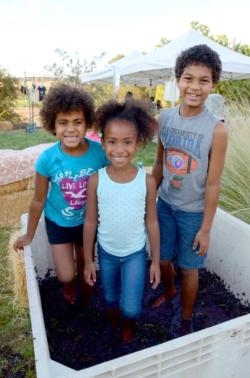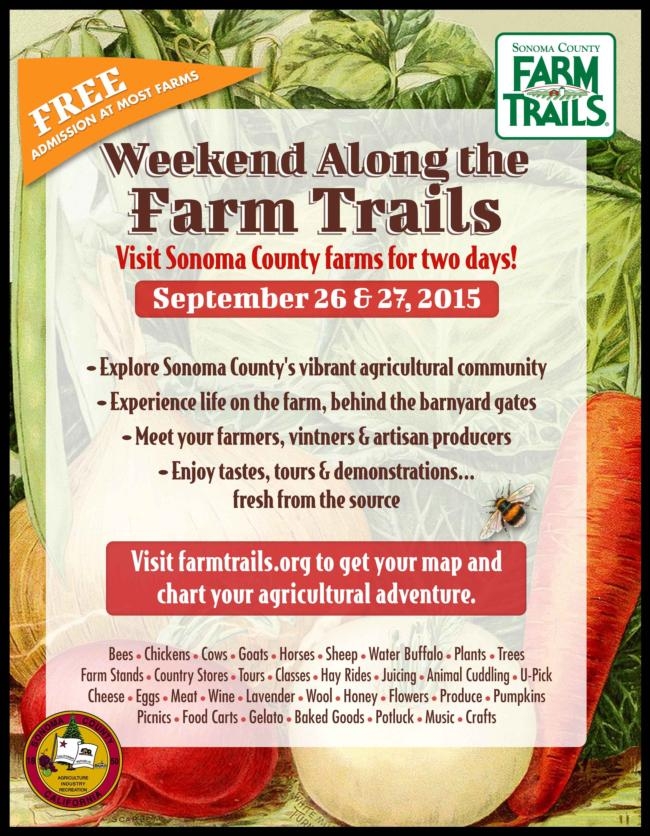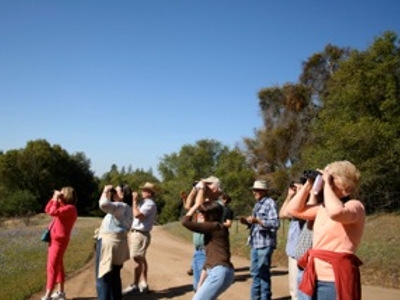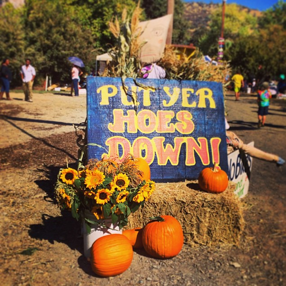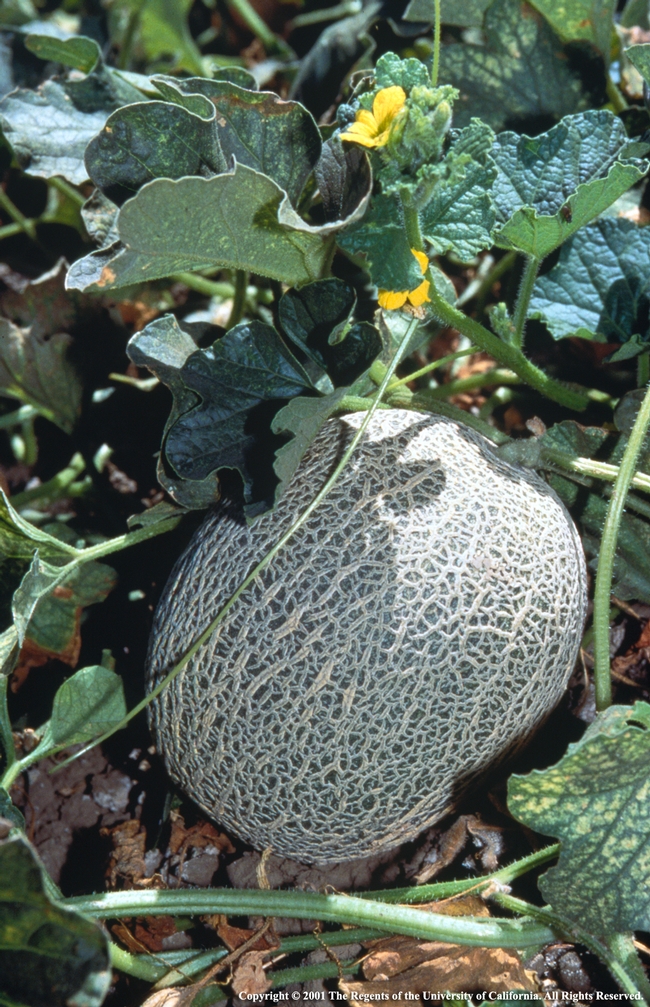Posts Tagged: Sonoma
Celebrate the harvest - visit a farm
All over California, farmers are harvesting the last summer crops, picking apples, crushing grapes, and watching pumpkins ripen. All over California, farmers also welcome the public to enjoy family-friendly harvest festivals, education and entertainment. To help urban and suburban Californians connect with local farms and agricultural events, UC Agriculture and Natural Resources (UC ANR) hosts the UC Agritourism Directory.
Here is a sampler of harvest season fun on the farms this month:
Apple Hill Growers' Association - El Dorado County
About 50 years ago, when a pear blight destroyed the pear crop in the El Dorado County foothill region near the small town of Camino, UC Cooperative Extension pomology specialist and farm advisor Ed Delfino worked with local growers to save their ranches. They began to plant apples, formed the Apple Hill Growers' Association and started inviting their neighbors from the valley to visit the farms for fresh apples and fun. Since the time of the group's first apple press and press picnic in 1964, the original ranch marketing association has blossomed into a very successful ranch marketing endeavor.
Today, Apple Hill includes over 55 ranchers, including Christmas tree growers, wineries, vineyards and a spa. For 50 years, Sacramento region families, along with those from the east side of the Sierras, have made a tradition of driving up Highway 50 to enjoy picking apples, drinking wine, arts and crafts, pies, jams, jellies, music, and other activities. Visitors will find their day filled with old-fashioned fun.
The ranches are now open, with U-Pick orchards, entertainment, crafts, food and events at multiple locations. Learn more at www.applehill.com/.
For current information, download the free official Apple Hill™ app available through itunes or in the Google Play Store.
Oak Glen Apple Growers Association - San Bernardino County
Oak Glen is where the Apple Hill growers visited to learn how to share their apple harvest with the public, back in 1964. One of the most scenic spots in Southern California, Oak Glen is nestled in the heart of Apple Country, where it is cooler in the summer and winter offers snow. An hour or so from Los Angeles or Palm Springs, the 30 members of the Oak Glen Apple Growers Association offer a pleasant day trip or weekend away from town.
Visit orchards, pick fresh apples and drink fresh-pressed cider, and enjoy hot apple pie and other fresh baked apple treats at one of the family restaurants. Other attractions include an animal park, the Wildlands Conservancy, horse drawn wagon rides, the historical Oak Glen School House Museum and many activities offered by the different farms.
For apple picking and other fun: www.oakglen.net/
Grape Stomping, food, drink and fun in the Capay Valley, Yolo County - September 19, 2015
The 5th Annual Capay Crush will take place on Saturday, Sept. 19, 2015, from 4 p.m. to 9 p.m. in the beautiful Capay Valley, with a full slate of activities for all ages, including live music from Hot City Jazz and Dirty Cello, wine tasting, local food and grape stomping. Attendees are invited to camp overnight in the farm orchards. Event proceeds benefit the Kathleen Barsotti Non-Profit for Sustainable Agriculture (KBNP).
Guests can step into a vat of grapes and stomp until their feet are purple. Visitors can also ride the farm's tractor tram, enjoy free honey and olive oil tastings, take part in grape-themed activities and crafts, visit the petting zoo, and take a self-guided walking tour of Capay Organic.
Tickets are on sale now through Sept. 17, for $15 per person (children ages 12 and under are free) or 4 tickets for $50. After Sept. 17, tickets will be sold at the farm for $20 per person. Guests can also camp overnight at the farm in the orchards. Campsites can be reserved in advance for $35 each at www.capaycrush2015.eventbrite.com by Sept. 17 (admission not included).
To purchase tickets, go to: www.capaycrush2015.eventbrite.com. Call 1-800-796-6009 with any questions.
Work Day & Barn Dance at Pie Ranch by the coast - Pescadero, September 19, 2015
Pie Ranch is a small working farm by coastal Highway 1 that cultivates a healthy and just food system, from seed to table. Celebrate the spirit of community at this monthly ritual of touring or working together on the ranch, sharing locally grown food, and then spinning, laughing and dosey-doing together into the night.
RSVP for the work day and/or barn dance by emailing simone@pieranch.org. Private groups of more than 10 are encouraged to schedule a separate tour/program with the farm as they are attempting to keep the dance open and accessible to the greater community.
The work day begins at 2 p.m. Park past the roadside barn and check in at the roadside barn. The tour begins at 4 p.m. Entry is $10 to 20 per person, charged on a sliding scale. Pay at the Roadside Barn. A potluck dinner begins at 6 p.m. The event is alcohol free. The barn dance is from 7 to 10 p.m. Entry is $12 to 20 (sliding scale).
Children under 12 are free. More information on the work day and barn dance here.
News flash from Pie Ranch: "We planted the tomato plants in the spring and now we are up to our ears in tomatoes! While the summer bounty lasts, we will be holding our Cherry Tomato U-Pick everyday! Between 10 a.m. and 3 p.m., you are welcome to stop by the ranch and pick cherry tomatoes right off the vine!
Weekend Along the Farm Trails - Sonoma County - September 26 & 27, 2015
On Saturday and Sunday, Sept. 26 and 27, 2015, Sonoma County farmers will open their gates and barn doors to offer a behind-the-scenes peek at life on the farm.
Most of the stops are free.
All you need is transportation, a map of your route, a cooler to keep your purchases fresh, and a sense of adventure! Register now for your chance to
~ Explore Sonoma County's vibrant agricultural community.
~ Experience life on the farm behind the barnyard gates.
~ Meet your farmers, vintners & artisan producers.
~ Enjoy tastes, tours, & demonstrations fresh from the source.
Please note that some farms are only open one day. Feel free to contact the organizers with questions: farmtrails@farmtrails.org.
Please let the organizers know how many people will be in your car by selecting the corresponding number of tickets. Register now
Bloomingcamp Ranch Harvest Festival - Oakdale - September 26 & 27, 2015
Admission is free for this small farm festival near Modesto. Bring the family for live entertainment, chef demos, hayrides, games, kids art patch, pie eating contest, petting zoo, local arts and crafts and a car show. It all happens at Bloomingcamp Ranch, 10528 Highway 120, in Oakdale. For more information: www.bloomingcampranch.com or (209) 847-7437
Farm and Ranch Tour in the Sierra foothills - Mariposa County - September 26, 2015
The Mariposa AgriNature Association invites you to enjoy the bounty of their beautiful foothills. Experience the diversity of California's Sierra Foothills near Yosemite National Park.
The 2015 farm and ranch tour features four farm and ranch locations, along with a special display of the UC Master Gardeners near downtown along the Creek Parkway. Each location will showcase their unique agricultural operations, and vendors and artists will be set up as well.
Tickets are $10 per person, or $25 for a whole car. Kids under 12 are free when accompanying a paying adult. Tickets may be purchased at any tour location and are good for all locations. website/more info
Hoes Down Harvest Festival - Capay Valley, Yolo County - October 3 & 4, 2015
Join 5,000 festival attendees and 200 volunteers on the 300-acre organic Full Belly Farm for a full day, or a weekend, of fun, music, activities and education for all ages.
On Saturday, enjoy live music, circus performances, kids arts and crafts, a kids hay fort, contra dancing, agricultural workshops, farm tours, good food, a crafts fair and farmers' market, and more music. The silent auction features a range of affordable treats.
Camping is available on Saturday night in the walnut orchard, with breakfast and longer workshops and activities offered on Sunday.
All of the proceeds from the Hoes Down Harvest Celebration go to non-profit organizations that support sustainable agriculture and rural living.
Admission Prices:
Adults: $20 when purchased online – $25 at the gate.
Children (2-12): $5
Under 2: Free
Saturday Night Camping: $25 per car – No reservations needed.
website, tickets, more info
For more info about these events and more California farms and ranches to visit, see www.calagtour.org
Author: Penny Leff
Farmers get a taste of the possibilities of value-added farm products
When you're in a jam because you've grown more apricots than you can sell before the fruit quality deteriorates, what do you do? Make apricot jam!
Farmers, food artisans, agricultural support organizations and representatives from Sonoma County agencies recently gathered to share ideas for creating small-batch and artisanal “value-added” products featuring locally grown fruits and vegetables. On Nov. 3, UC Cooperative Extension hosted “Taste the Possibilities: Adding Value to Your Ag Business” in Sonoma County.
“Value-added production is an emerging food trend with the potential to help grow the local economy and support farmers' livelihood by tapping new revenue streams from preserving the peak of harvest and farm seconds that may otherwise go to waste,” said Julia Van Soelen Kim, UC Cooperative Extension advisor for the North Bay Area.
Farmers shared their inspiring success stories and business people provided insight on sourcing local produce, using commercial kitchens and co-packers, obtaining the right permits and registrations, and leveraging best practices in business planning and marketing.
There are new and emerging opportunities for value-added production including Cottage Food Operations, which allow individuals to prepare and package certain shelf-stable foods in home kitchens, and the recent Sonoma County zoning-code change that allows small-scale agriculture processing on farms.
But not everyone has the time, interest or ability to make the products themselves, said Merrilee Olson, a specialty food producer who participated in the workshop.
Her business, PRESERVE Sonoma, does custom co-packing services and private labels for growers and food entrepreneurs. As a co-packer, Olson makes value-added products in her commercial kitchen and cannery. She also helps food entrepreneurs connect with farmers and other sources of local produce.
“I started this business to help farmers get value-added products made,” said Olson, who opened in 2011, before the cottage food law passed. At that time farmers were losing money to overproduction and they didn't have very many options.
When a farmer found himself with an extra 1,500 pounds of ripe apricots, Olson turned them into apricot jam, which he is selling at the farm's store and farmers markets. Some people come to her with old family recipes and their own ideas for products. For tomato growers, she has made pasta sauce, salsa, tomato soup and bloody mary mix. “The bloody mary mix was the farmer's idea, and that will be on Whole Foods shelves,” Olson said.
“The idea of value-added products is well-known to farmers, but they may not know they don't have to do it themselves,” Olson said. “Some farmers don't really want to make the product, they want to farm. Even if you have a well-equipped home kitchen, making cottage foods isn't for everyone and you need insurance so it's easier to pay someone else to do it. We are a licensed cannery, which means we can make products like pickles, which are not covered in the cottage food law. ”
Olson thinks of the value-added farm products as preserving a way of life as well as food.
“Many farmers weren't aware of the range of options for value-added production that can help them use the abundance of their harvest, diversify their operations and generate new income for their ag businesses,” said Karen Giovannini, UC Cooperative Extension agricultural ombudsman in Sonoma County who helps local farmers expand their agriculture enterprises and navigate the regulations and permitting needed to do so.
“These emerging opportunities support farmers and food entrepreneurs, as well as regional economic development, and help to build a more robust local food system,” said Van Soelen Kim, who specializes in food systems for Sonoma County as well as Marin, Mendocino and Napa counties.
The workshop was offered as part of the “Opportunities in Ag Business” series presented by UC Cooperative Extension and Sonoma County Department of Health Services and was sponsored by American AgCredit. The educational workshop series aims to help make family farming economically viable, inspire the next generation of farmers, and support the development of a vibrant local food system.
Cherish the Gravenstein
If an apple a day keeps the doctor away, what does a Gravenstein apple pie do?
It causes a stampede to the dining room table, that's what it does. Expect to see chairs overturning, plates flying and forks spinning.
That's because Gravensteins make the best pies. As any apple pie aficionado will tell you: the best pies are the "G" pies: Gravenstein (first) and Granny Smith (second).
The Gravenstein apple reigned as the preferred apple on our family farm in western Washington. We found the sweet-tart apple "perfect" for eating right off the tree, or made into pies, applesauce and apple cider. The cows liked them, too. A gentle nudge on the tree, and - eureka! - apples would magically fall to the ground. Talk about happy cows!
This heirloom apple also reigns supreme in Sonoma County. Just ask the Gravenstein apple farmers, area residents, restaurants and the tourists who line up to buy a bag or two.
That's because of its flavor, its propensity for being in the right place (pie) at the right time, and its short season make it even more treasured. Plus, this is an apple with an aroma. The delightful fragrance will permeate your kitchen.
It's a short, squatty looking apple, streaked with red. Sometimes Nature's paintbrush turns the thin streaks into thick bands. And the stems are short - so short and so susceptible to falling from the tree that, "growers estimate they lose 40 percent of their apples even before they are ripe," wrote Carolyn Jung of The Day newspaper, New London, Conn., in her interview with Paul Vossen, UC Cooperative Extension advisor in Sonoma and Marin counties, for a Sept. 8, 1999, article.
First described in 1797, the Gravenstein originates from Denmark, where it's known as "Gråsten." It took a couple of centuries to do it, but in 2005, Denmark declared it the "national apple."
How did it get to Sonoma County? Russian trappers first planted it there in 1811. The good citizens of Sonoma so liked the apple that they named a major artery the "Gravenstein Highway." Over the last six decades, however, "Sonoma County's Gravenstein orchards have declined by almost 7,000 acres and are currently down to 960 acres," according to an article on the Slow Food USA website.
Why? Farmers find it more profitable to grow grapes.
Also, it's not an easy apple to market. It's an early variety with a very short season, usually during a few weeks in August. Blink and it's gone.
And, it's an apple you won't find in your local produce section, tucked among the Red Delicious, Galas, Fujis, Pink Ladies and Granny Smiths.
"They don't travel well, and they don't last long (short season)," says Daniel Sumner, professor in the Department of Agricultural and Resource Economics at UC Davis and director of the UC Agricultural Issues Center. "To consumers, this is the kiss of death."
Enter the Slow Food movement. To help preserve the heirloom apple, the Russian River Slow Food group contacted area restaurants and asked that it be featured in their desserts. Getting into the preserve-the-Gravenstein act, the FruitGuys, a company that ships organic fruit to customers, donated 17 percent of this year's proceeds back to the Gravenstien apple farmers.
Every little bit helps.
In the meantime, Sebastopol continues to celebrate its annual Gravenstein Fair; this year the event took place Aug. 11-12.
In search of Gravensteins, we drove to Sebastopol on Sunday, Aug. 19, just as the season was about to end. "Ours will be gone in a couple of days," a farmer told us.
"Which apple makes the best pie?" we asked. "Granny Smiths or Gravensteins?
"Gravensteins," the farmer said. "Hands down."
We agree.
Here's our family recipe for Gravenstein apple pie. We favor using brown sugar instead of granulated white sugar. And we mix the brown sugar with cinnamon and nutmeg.
Crust for 9.5-inch pie
2 cups flour
1/2 teaspoon baking powder
2/3 cup butter-flavored Crisco, chilled
3/4 teaspoon salt
6 tablespoons water, cold
Sift flour, baking powder and salt. Mix in Crisco until the dough pieces are pea-sized. Add cold water as needed, 6 tablespoons or more, and form into a ball. Roll out dough into a circular shape and invert on pie pan.
Filling for 9.5-inch pie
8 cups of apples, peeled, cored and sliced
1 teaspoon cinnamon
1/2 teaspoon nutmeg
3/4 cup loosely packed brown sugar
1-1/2 tablespoons of butter
Preheat oven to 425 degrees. Gently mix together (with fork) brown sugar, cinnamon and nutmeg and then mix lightly through the apples. Before pouring the mixture into the pie pan, sprinkle a little cinnamon (less than 1/4 teaspoon) on the lower crust. Dot the heaping apple mixture with thin slices of butter. Place top crust on pie. Slit with sharp knife in several places and poke with prongs of fork. Sprinkle a dash of nutmeg on the crust. Line the edge with 1/2-inch strip of aluminum foil to prevent excessive browning. Bake at 425 degrees about 50 minutes or until the crust is lightly browned and the apples are cooked through. Test with fork.
Warning: the aroma of this pie will attract all the neighbors, their families, their friends and their friends' friends.
No wonder Luther Burbank said that “if the Gravenstein could be had throughout the year, no other apple need be grown.”
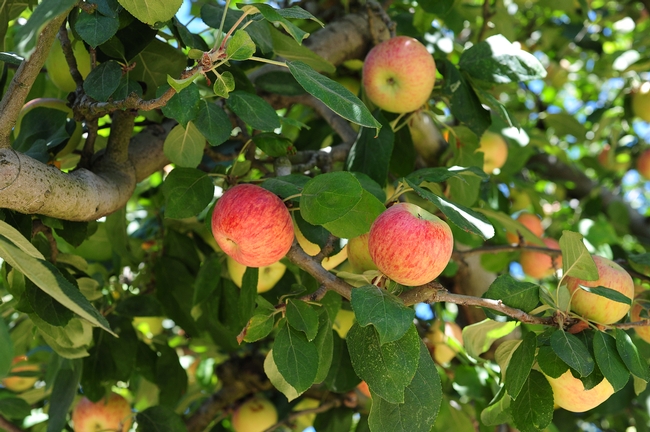
Gravenstein apples hang from a tree in Sonoma County. (Photo by Kathy Keatley Garvey)

Gravensteins are usually streaked with red, but Nature's paintbrush created this effect. (Photo by Kathy Keatley Garvey)
UC, CSU team up on agricultural, environmental research projects
Leadership of California’s higher education systems made the funding available to jointly address issues in agriculture, natural resources and human sciences. Project criteria include collaborative research, teaching, or course development; development of student internship opportunities; and workshops, conferences, and symposia. Eight projects totaling more than $79,500 were selected from 30 proposals submitted.
“These research projects will help leverage limited resources to produce quick results on important issues in California,” said Neal Van Alfen, dean of the College of Agricultural and Environmental Sciences at UC Davis. “They are also building stronger connections among researchers throughout the state and providing hands-on learning opportunities for students.”
Researchers involved in this year’s projects are from UC Davis, UC Berkeley and California State University campuses at Chico, Fresno, Humboldt, Pomona, Sonoma, San Marcos and San Luis Obispo. The awarded projects, with principal investigators, are listed below:
- “Estimating residential water demand functions in urban California regions” — Economists from UC Berkeley and Cal Poly San Luis Obispo will estimate residential water demand of municipalities and water companies that serve 19 million people in the Bay Area and Southern California. (Maximilian Auffhammer, Stephen Hamilton)
- “Reintroduced mammals and plant invaders as key drivers of ecosystem processes in coastal and interior grasslands” — Researchers from Sonoma State University and UC Davis will study how reintroducing tule elk and reducing invasive Harding grass affects the availability of soil nutrients and the composition of plant communities. (Caroline Christian, J. Hall Cushman, Valerie Eviner)
- “Genetics of plant defense responses to pesticides and spider mites on grapes” — Scientists from UC Davis and Cal Poly San Luis Obispo will conduct laboratory, greenhouse and field studies to learn more about factors affecting grapevine response to spider mites, including cultivar resistance, drought impact and pesticide exposure. (Michael Costello, Richard Karban, Andrew Walker, Jeffrey Wong)
- “Defining the functions of polyphenol oxidase in walnut” — Through genetic analysis, researchers at CSU San Marcos and UC Davis seek to learn more about an enzyme involved in the postharvest browning of cut or bruised fruit. (Matthew Escobar, Monica Britton, Abhaya Dandekar)
- “Modeling the costs of hazardous fuel reduction thinning treatments and removal of woody biomass for energy” — Researchers from Humboldt State University, UC Davis, and the U.S. Forest Service will develop a model to estimate the costs of removing hazardous wildland fuels with different equipment and systems over a wide range of forest stand, site and road conditions. (Han-Sup Han, Bruce Hartsough)
- “Restoration of pollinator communities and pollination function in riparian habitats” — Researchers from California State University, Chico, and UC Davis will characterize native pollinator communities at restored riparian habitats within the Central Valley and test whether successful restoration of pollinator communities also leads to restoration of pollination. (Christopher Ivey, Neal Williams)
- “Estimating alfalfa’s impact on regional nitrogen budgets and nitrate leaching losses in the Central Valley of California” — Researchers from California State University, Fresno, and UC Davis will collect alfalfa and non-legume plants from irrigated fields and also identify San Joaquin Valley farm sites for a multi-year study of alfalfa’s impact on regional nitrogen budgets, groundwater nitrate leaching, and nitrogen requirements of rotation crops. (Bruce Roberts, Stuart Pettygrove, Daniel Putnam)
- “Community and ecosystem response to elevated nitrogen in managed grassland ecosystems” — Restoration ecologists from Cal Poly Pomona and UC Berkeley will investigate how elevated nitrogen levels affect competition among native and exotic plant species with regard to fuel characteristics at UC’s South Coast Research and Extension Center. (Erin Questad, Katharine Suding)
Reports on project outcomes are expected in December 2012.
Listeria outbreak renews call for federal regulations
UC food safety expert Michele Jay-Russell said federal officials should draw inspiration from the Leafy Green Marketing Agreement when they finalize the new regulations. California and Arizona put the agreement in place after the 2006 spinach E. coli outbreak, the article said. It includes a wide range of food safety metrics, from how often to test irrigation water to the optimal method of composting and proper use of animal manures.
Jay-Russell also said research into animal biology could help identify new strategies to prevent or treat listeria. Unlike other pathogens such as E. coli, listeria can sicken both humans and animals. Because sheep, goats and cattle develop similar symptoms to humans, she suggests studies of this parallel animal disease could lead to a better understanding of human illness.
Every day is Food Day
Cathryn Couch, The Santa Rosa Press Democrat
Sonoma County is blessed with a rich agricultural heritage and a strong local food culture. Today, growing interest and concern is merging with strong support from the Sonoma County Board of Supervisors and new opportunities for collaboration. Among the highlights of "exciting food happenings" listed in this article was the first county-wide Food Forum presented in January by the Sonoma County Food System Alliance. The alliance, together the Board of Supervisors and UC Cooperative Extension, gathered nearly 300 stakeholders to explore what’s working and identify what’s needed to create a healthy food system for all.
Resident, farming scientist outraged by city’s pruning job
Eiji Yamashita, Hanford Sentinel
UC Cooperative Extension farm advisor Bob Beede is outraged by the way three ornamental Bradford pear street trees near his home were pruned by the City of Hanford.
“They came in and butchered all of my lower foliage off my trees. If you talk to professional arborists, they’d tell you this is the wrong way to prune an ornamental tree,” Beede said.
Beede is a veteran farm advisor for the University of California Cooperative Extension in Kings County. He works closely with farmers in the area to improve their fruit tree production, the newspaper reported.



